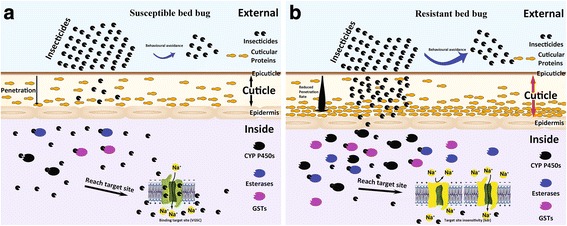Fig. 1.

Schematic of potential behavioral and physiological changes involved in insecticide resistance in bed bugs. a Susceptible bed bug. b Resistant bed bug. The various forms of resistance act in compounding layers to counteract the effect of the insecticide. For example, direct application of an insecticide such as a pyrethroid may kill the bed bugs; however due to the ‘excito-repellency’ nature of this class of compounds, some bed bugs may avoid insecticide exposure (potential behavioral resistance). If the bed bugs come into contact with an insecticide, the cuticle may be thickened or remodelled by over-expression of cuticular proteins, which will reduce the rate of insecticide penetration (penetration resistance) beyond the cuticular layer. If the insecticides enter the insect, bed bugs can enhance metabolic detoxification (e.g. P450s, esterases, GSTs) to inhibit the insecticidal effect (metabolic resistance). Finally, if the insecticides reach the neurological system to act on the target sites (such as the VGSC), point mutations (e.g. kdr mutations) can reduce the sensitivity of the insecticide target site to the insecticide (target site insensitivity)
